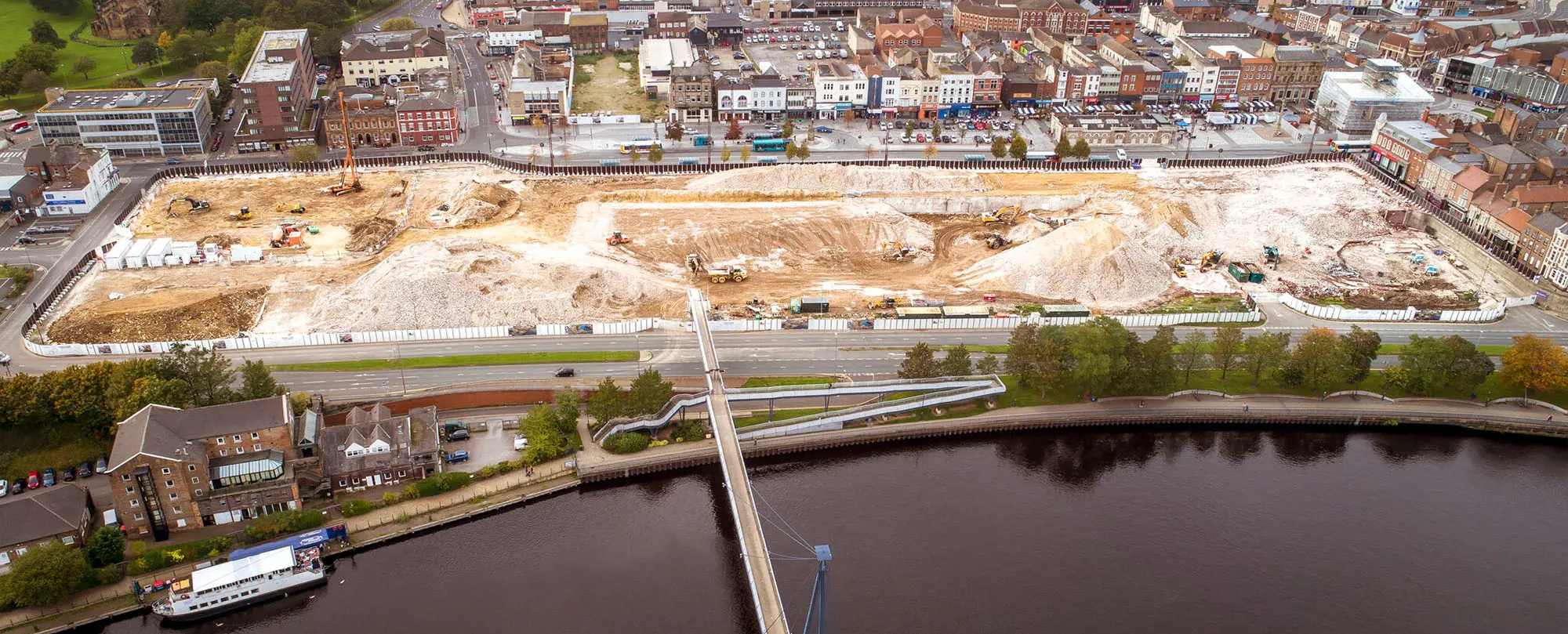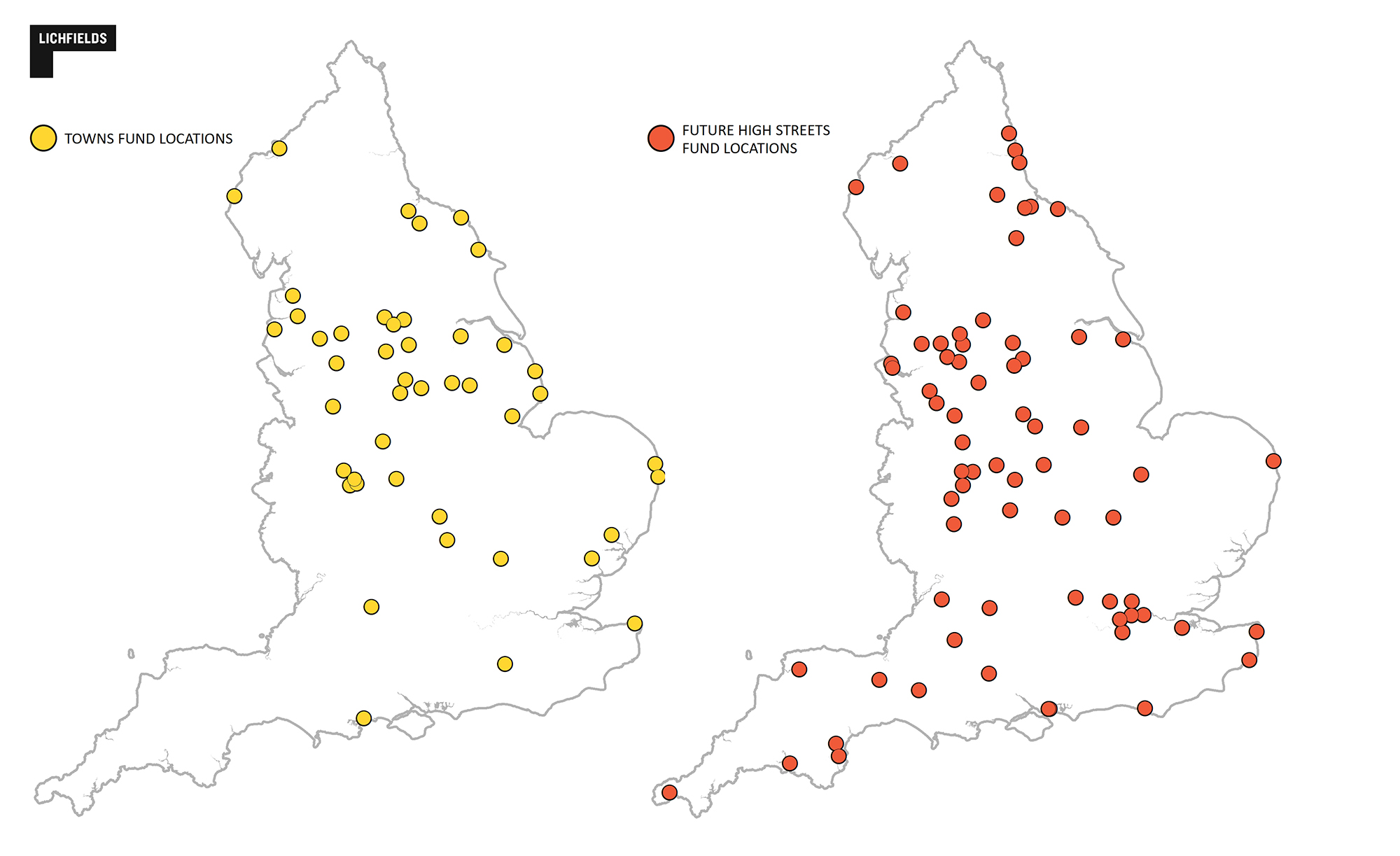Over recent years, the Government has launched a number of funding streams, aiming to breathe new life into our town and city centres. Lichfields has been at the forefront of the drive to capitalise on this funding, having worked with stakeholders across the country to deliver much-needed change.
Here, we provide an update on recent funding allocations and explore how Lichfields’
Revitalise toolkit is helping to shape our towns and cities.
The four key funding streams currently available to help deliver town centre transformation are:
1. Towns Fund
In September 2019, 101 places were invited to put forward proposals for a Town Deal as part of a £3.6 billion fund
[1]. This was designed to provide these towns with the tools to design and deliver a growth strategy for their area, contributing to the Government’s objective of rebalancing the national economy
[2] - recognising the role that town centres can play in this. In the March 2021 Budget, the Chancellor announced which 45 places had successfully secured funding.
2. Future High Streets Fund
Originally unveiled as part of the 2018 Budget, the £1 billion Future High Street Fund (‘FHSF’) was designed to support the development of high streets in a way that drives growth, improves customer experience and ensures future sustainability
[3]. In December 2020, 72 successful applicants were announced, receiving allocations varying from £1m to £25m.
3. High Streets Heritage Action Zones
A portion of the FHSF is reserved to support the regeneration of heritage high streets. The High Streets Heritage Action Zones Fund is open to applications from high streets within conservation zones and is administered by Historic England
[4].
4. Levelling Up Fund
This £4.8 billion fund falls within the Government’s much-discussed ‘Levelling Up’ agenda. It looks to provide funding to projects that spread opportunity to historically overlooked areas
[5]. Whilst not explicitly town centre focused, the fund has supported a number of town centre regeneration projects.
In January 2023, the Government announced the results of the second round, awarding £2.1 billion to 111 projects. Combined with the
first round results, the Levelling Up Fund has awarded a total of £3.8 billion to 216 projects. The third round is expected to be announced in advance of the 2024 Autumn Statement.
Distribution and allocation
Announcements of funding allocations and their distribution have generated lively discussion.
There has been a weighting of Central Government funding towards areas in the north-west of England. In the second round of Levelling Up Funding, the region received 27 awards, constituting 16% of all funding awarded
[6].
The northern weighting is also reflected in the allocations of funding for the FHSF and the Towns Fund, the distribution of which is shown below.
However, there is current discussion around how and whether the various funding allocations are being spent, and a recent article in The Observer
[7] newspaper found that, across the UK, 43% of Levelling Up funding is currently unspent. Furthermore, 95% of the local authorities that received funding in 2022-23 have been so far unable to spend their full allocation, with critics attributing this to a lack of capacity within local authorities and the complexity of the funding process.
Whilst at face value, this may be of concern to those keen to see the levelling up funding start to bear fruit, it is hardly surprising to anyone with experience in the planning and development sector. While Town Investment Plans and other high street strategies used for funding bids will all have been justified through a strong rationale, few are likely to have been subject to detailed design development, and similarly, very few of the schemes for which funding was allocated will have benefitted from planning permission. Furthermore, given the very significant price inflation over the last two years in particular, many schemes are likely to have become undeliverable in their original form due to escalating costs. In this context, we are aware of funded schemes where there has needed to be a re-design, and amendments sought to planning approvals, in order to ensure deliverability. It is therefore surely too early to draw judgement on whether the allocated funds are likely to be spent.
Success stories
In our experience, local authorities have been working hard to deliver projects associated with funding bids. Lichfields has a proven track record of working with local authorities and other stakeholders to deliver town centre regeneration, drawing upon the funding support available from the above sources.
Bishop Auckland
Bishop Auckland, County Durham’s second town, has taken a culture and heritage-driven approach to rejuvenating its town centre.
A Heritage Action Zone (HAZ) was approved in 2018, allowing the town to receive funding and expertise from Historic England to tackle heritage at risk and enable re-use of empty buildings
[8].
Lichfields worked with Ryder Architecture to prepare the Bishop Auckland Town Centre Masterplan. This identifies various regeneration opportunities, overall looking to help broaden the town centre offer away from retail, to help increase dwell-time, and enhance the environment more generally. This masterplan formed a key part of the evidence base that was used to bid for the FHSF.
Lichfields was appointed by the Council to provide specialist economics input to the bidding processes, helping to secure Bishop Auckland a total of £19.9m from the FHSF and £32.2m from the Towns Fund. This funding will contribute to the provision of the physical infrastructure required to ensure the town can accommodate additional visitors
[9].
Stockton-on-Tees
Stockton-on-Tees Borough Council is using the FHSF to undertake a transformative approach to the regeneration of Stockton Town Centre. The centre had a unit vacancy rate which was around two times the national average and radical action was needed to address the decline of the retail sector.
In December 2020, the Council received a provisional offer of £16.5m from the FHSF, in addition to £20m from the Tees Valley Combined Authority. Following the acquisition of the two large shopping centres by the Council, a masterplan was developed for the Castlegate Shopping Centre site to help create a new waterfront development.
Lichfields secured outline planning permission in August 2021 for the redevelopment of the Castlegate site, with reserved matters approval being granted for a new urban park and a Community Diagnostics Centre in July 2023 and August 2023 respectively.
In Stockton, the FHSF has proven to be a powerful financial tool in enabling this town centre to think and act boldly, forming its own unique solution to the decline of town centre retail.
Derby
In Derby, the FHSF is serving as a catalyst to unlock a key area of the city centre. The Eagle Market is a large market hall in the heart of Derby city centre, which has suffered from sustained high vacancy rates for a number of years.
Derby City Council secured £15m funding from the FHSF, with part of this funding committed to the delivery of the Eastern Gateway, to transform the entrance to the Eagle Market, to create a welcoming arrival from the bus station.
In August 2023, Lichfields secured full planning permission for the Eastern Gateway. The scheme involves the redevelopment of the Eagle Market with a new leisure development and to create a new landscaped area to attract families and children, with curated F&B (Food and Beverage) outlets and associated seating bringing vitality to the site.
In the longer term, the Eastern Gateway investment aims to facilitate the redevelopment of a wider Eagle Quarter, encompassing the remainder of the Eagle Market site and potentially the site of the Derby Theatre (subject to its relocation elsewhere in the City).
Summary & conclusion
The government funding streams identified above are now being used to deliver significant change in many town centres throughout England. Concerns have been raised that a significant proportion of the allocated funding is yet to be spent, but it is too early to make a judgement in relation to this.
Lichfields’ experience is that funding can be an important and positive catalyst for change. Here, we provide four key reflections on the opportunities available from these funding streams:
- They can serve to unlock difficult town-centre sites, which may otherwise struggle to attract investment, ultimately providing a catalytic effect for regeneration efforts.
- They offer authorities the opportunity to play a leading role in shaping town centres. This follows the restriction of their control with the introduction of Class E and the expansion of Permitted Development rights.
- Government funding can provide opportunities to act more boldly and think beyond traditional notions of ‘what a town centre is’.
- Funding can offer the greatest impact when used to add value to, work in conjunction with, or create the conditions suitable for private sector investment.
Our recently launched toolkit –
Revitalise – provides local authorities and other stakeholders with a range of services to help transform town centres across the country, similar to those employed in Bishop Auckland, Stockton, Derby and elsewhere. Please do get in touch if you would like to discuss any of your potential town centre projects.
[1] https://townsfund.org.uk/[2] Towns Fund prospectus[3] Future high streets fund[4] Regenerating historic high streets[5] Landmark Levelling Up Fund to spark transformational change across the UK - GOV.UK (www.gov.uk)[6] Which areas have benefited from the Levelling Up Fund? (parliament.uk)[7] Almost all UK councils have not spent total share of levelling-up fund | Local government | The Guardian[8] Bishop Auckland: A cultural revolution[9] Moving on up: levelling up town centres across northern england
Image credit: Stockton-on-Tees Borough Council





